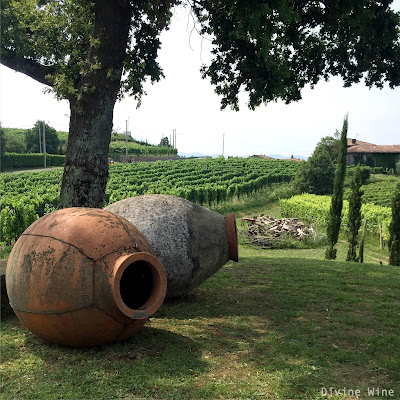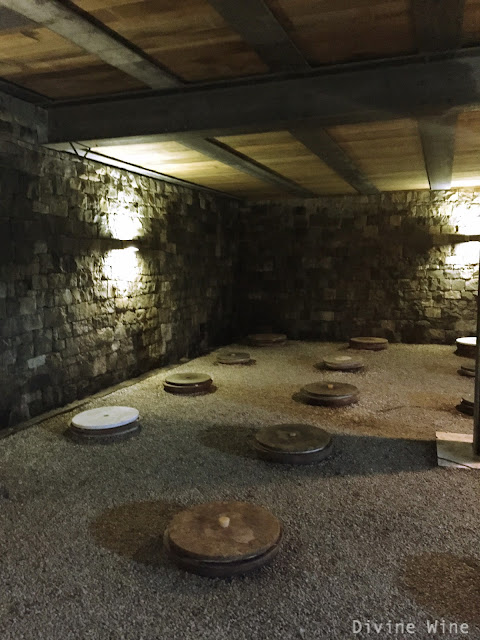Where it all started
Some argue
that orange wine is just a whim of fashion. However, archeological findings
from Caucasus, or modern day Georgia, locate the origin of wine making to this
very area. The excavated red clay vessels with wine residues on them support
the notion of orange wine being the first wine ever made, which took place
around 6000 B.C. Furthermore today, the very same type of thick walled, cone
shaped, red clay vessels, kvevris (or qvevris), are used for fermenting and
storing orange wine in Georgia as they were roughly 8000 years ago. Kvevris
surely make oak and stainless steel look like whims of fashion!
In addition
to their constant success in Georgia, kvevris have increasingly made their way
to Europe since 1990’s. Currently, the heartland of kvevri fermented and
maturated wine is in North-East Italy, in Collio-Brda area. This region is
situated at the border of Italy’s Friuli and Slovenia. Orange wine is also
produced in various vessels (plastic, oak, steinless steel) at numerous corners
of the world, including Croatia (the neighbour of Italy and Slovenia), as well
as other parts of Italy, Sicily, France, Austria, California and Australia.
Kvevris, however, are hardly seen outside Georgia and Italian/Slovenian
Collio-Brda area.
What is a
kvevri?
Kvevri is a
cone shaped red clay vessel lined with beeswax. They vary in size from small
(100 liters) to enormous (10 000 liters), and are sometimes also called
(slightly inaccurately) amphoras. However, kvevris differ from amphoras in that
they do not have handles, and are shaped differently. In fact, at a quick
glance kvevris appear really impractical: you can’t carry them and they will
fall on their side due to their sharp shape when placed on a surface. Why on
earth were they made this way 8000 years ago, and still are?
Kvevri is
buried in the ground
Kvevri’s
odd shape is geniously functional considering the winemaking circumstances
thousands of years ago. There was no technology for temperature control or
chemicals available for sanitation (not to mention understanding of microbes). A kvevri
buried in the ground provides the wine with steadily temperature controlled,
cool environment. Soil in the ground remains cool and in relatively constant
temperature year round compared to air temperature, which might vary in
Mediterranean from blazing hot in the summer to minus degrees Celsius in the
winter. Temperature variation and high temperatures are detrimental to wine
aromas. Hence, kvevris.
Lacking
tannin, white wine is especially susceptible to oxidation and infection. This
is why ancient white wine was made with prolonged skin contact to extract
tannin, a natural antioxidant and preservative, to the wine. Although tannin
shields white (or orange) wine from being spoiled, extended skin contact is not
without risks. Especially stalks and pips are plentiful in bitter compounds and
in abundance result in unpleasant, astringent wine. The solution is kvevri’s
shape. In the start of fermentation most of the skins, pips and stalk material
is floating on the grape juice. As fermentation continues, more and more of
this cap starts to fall on the bottom of the fermentation vessel. The first to
fall down are pips and the stalks; the skins follow later. In the cone shaped
kvevri, these most bitter components of the grapes become soon covered with
grape skins. In addition, kvevri’s conical shape nicely limits the contact area
between the fallen solid material and the wine, and on top of that, allows only
minimal contact between the wine and the bitterest part of the grape material. Genious!
Natural wine
Orange
wines are produced in variety of styles – with more or less prolonged skin
contact; aging the wine for months or years; in all kinds of vessels including
kvevris, stainless steel, plastic and oak. However, practically all orange wine
producers are minimally interventionistic, meaning e.g. that they rarely add
commercial yeasts to their wines or use herbicides or pesticides in their
vineyards, and often use only very small amounts of sulphites to protect their
wines from spoilage. Some of them are certified organic or biodynamic
producers. This minimally interventionistic approach is rather ambiguously
referred to as “natural wine”-movement, and due to its broad definition, covers
a multitude of more and less adventurous wine making philosophies. Getting
acquainted with orange wine will inevitably bring you in contact with natural
wine and its various quality levels as well. So, let’s enjoy this
adventure together!

